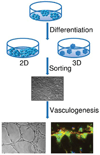Transplantation of human embryonic stem cell-derived endothelial cells for vascular diseases
- PMID: 19097085
- PMCID: PMC2866109
- DOI: 10.1002/jcb.22003
Transplantation of human embryonic stem cell-derived endothelial cells for vascular diseases
Abstract
Using endothelial cells for therapeutic angiogenesis/vasculogenesis of ischemia diseases has led to exploring human embryonic stem cells (hESCs) as a potentially unlimited source for endothelial progenitor cells. With their capacity for self-renewal and pluripotency, hESCs and their derived endothelial cells (hESC-ECs) may be more advantageous than other endothelial cells obtained from diseased populations. However, hESC-ECs' poor differentiation efficiency and poorly characterized in vivo function after transplantation present significant challenges for their future clinical application. This review will focus on the differentiation pathways of hESCs and their therapeutic potential for vascular diseases, as well as the monitoring of transplanted cells' fate via molecular imaging. Finally, cell enhancement strategies to improve the engraftment efficiency of hESC-ECs will be discussed.
Figures



Similar articles
-
Functional and transcriptional characterization of human embryonic stem cell-derived endothelial cells for treatment of myocardial infarction.PLoS One. 2009 Dec 31;4(12):e8443. doi: 10.1371/journal.pone.0008443. PLoS One. 2009. PMID: 20046878 Free PMC article.
-
Differentiation, survival, and function of embryonic stem cell derived endothelial cells for ischemic heart disease.Circulation. 2007 Sep 11;116(11 Suppl):I46-54. doi: 10.1161/CIRCULATIONAHA.106.680561. Circulation. 2007. PMID: 17846325 Free PMC article.
-
Efficient differentiation of human embryonic stem cells to arterial and venous endothelial cells under feeder- and serum-free conditions.Stem Cell Res Ther. 2015 Dec 30;6:261. doi: 10.1186/s13287-015-0260-5. Stem Cell Res Ther. 2015. PMID: 26718617 Free PMC article.
-
MicroRNA regulation of endothelial homeostasis and commitment-implications for vascular regeneration strategies using stem cell therapies.Free Radic Biol Med. 2013 Sep;64:52-60. doi: 10.1016/j.freeradbiomed.2013.04.037. Epub 2013 May 9. Free Radic Biol Med. 2013. PMID: 23665307 Review.
-
Directing human embryonic stem cells to generate vascular progenitor cells.Gene Ther. 2008 Jan;15(2):89-95. doi: 10.1038/sj.gt.3303005. Epub 2007 Aug 16. Gene Ther. 2008. PMID: 17700707 Review.
Cited by
-
Functional characterization of embryonic stem cell-derived endothelial cells.J Vasc Res. 2011;48(5):415-28. doi: 10.1159/000324752. Epub 2011 May 31. J Vasc Res. 2011. PMID: 21625175 Free PMC article.
-
Multiple therapeutic effect of endothelial progenitor cell regulated by drugs in diabetes and diabetes related disorder.J Transl Med. 2017 Aug 31;15(1):185. doi: 10.1186/s12967-017-1280-y. J Transl Med. 2017. PMID: 28859673 Free PMC article. Review.
-
Comparative Study of Human Pluripotent Stem Cell-Derived Endothelial Cells in Hydrogel-Based Culture Systems.ACS Omega. 2021 Mar 2;6(10):6942-6952. doi: 10.1021/acsomega.0c06187. eCollection 2021 Mar 16. ACS Omega. 2021. PMID: 33748608 Free PMC article.
-
Bioactive hydrogels for bone regeneration.Bioact Mater. 2018 May 26;3(4):401-417. doi: 10.1016/j.bioactmat.2018.05.006. eCollection 2018 Dec. Bioact Mater. 2018. PMID: 30003179 Free PMC article. Review.
-
Directing human embryonic stem cells towards functional endothelial cells easily and without purification.Tissue Eng Regen Med. 2016 Jun 9;13(3):274-283. doi: 10.1007/s13770-016-9076-3. eCollection 2016 Jun. Tissue Eng Regen Med. 2016. PMID: 30603409 Free PMC article.
References
-
- Chen SS, Fitzgerald W, Zimmerberg J, Kleinman HK, Margolis L. Cell-cell and cell-extracellular matrix interactions regulate embryonic stem cell differentiation. Stem Cells. 2007a;25:553–561. - PubMed
-
- Chen T, Bai H, Shao Y, Arzigian M, Janzen V, Attar E, Xie Y, Scadden DT, Wang ZZ. Stromal cell-derived factor-1/CXCR4 signaling modifies the capillary-like organization of human embryonic stem cell-derived endothelium in vitro. Stem Cells. 2007b;25:392–401. - PubMed
-
- Cho SW, Moon SH, Lee SH, Kang SW, Kim J, Lim JM, Kim HS, Kim BS, Chung HM. Improvement of postnatal neovascularization by human embryonic stem cell derived endothelial-like cell transplantation in a mouse model of hindlimb ischemia. Circulation. 2007;116:2409–2419. - PubMed
Publication types
MeSH terms
Grants and funding
LinkOut - more resources
Full Text Sources
Other Literature Sources
Medical

